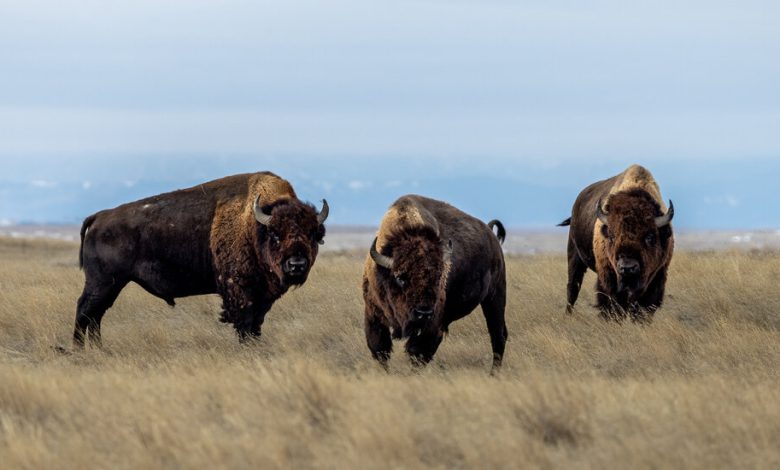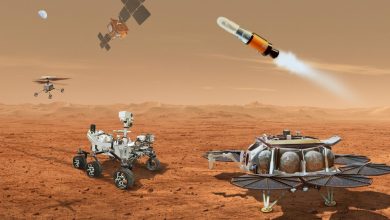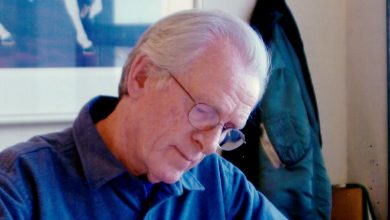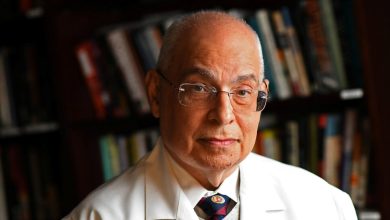Where the Bison Could Roam

MALTA, Mont. — Around 200 chocolate-brown bison raise their heads, following the low growl of a pickup truck slowly motoring across the sagebrush-studded prairie.
Snorting and quietly bellowing, their feral odors riding the wind, they slowly trot across the prairie hills, eager to maintain distance from the truck.
This knot of bison — colloquially referred to as buffalo, though they are not the same species — is part of a project to rebuild a vast shortgrass prairie not only to return large numbers of bison here, but also to eventually restore the complex and productive grassland ecosystem the animals once engineered with their churning hooves, waste, grazing and even carcasses.
“When you have large numbers on the landscape, they impact everything,” Scott Heidebrink, the director of bison restoration for American Prairie, a nonprofit conservation group, said of the animals. “There are ways that bison were impacting the landscape that we haven’t even thought about.”
Since 2001, American Prairie — formerly known as American Prairie Reserve — has been working to create a fully functioning wild prairie, complete with herds of bison thundering across the landscape and playing their historical ecological role.
Experts originally thought it would take a decade or so to restore the bison-driven grassland ecosystem that would, in turn, replenish native species, including numerous grassland birds, river otters, prairie dogs, grizzly bears and wolves — all of which have been eliminated or diminished, largely by farming and livestock grazing.

Three of the bison on the American Prairie reserve in Montana. Between 30 million and 60 million bison once roamed the United States.
However, land costs, politics and other complications have pushed that goal well into the future, and reaching it has proved to be difficult. Researchers and experts have since become more realistic, understanding that the original timetable to create such a vast grassland is just not feasible.
Between 30 million and 60 million bison once roamed parts of the United States, primarily in the Great Plains. They were a “keystone” species in a complex ecological web, creating a cascade of environmental conditions that benefited countless other species.
More on Birds
- An Epic Flight: In search of an endless summer, bar-tailed godwits fly 7,000 miles each year — from Alaska to New Zealand. And they do it without stopping to eat, drink or rest.
- An Uneven Crisis: The risk of extinction, a study suggests, is not randomly or equally spread across the avian family. Instead, the most distinctive birds are likely to vanish first.
- Hammering Away: A study shows that woodpeckers do not absorb shocks during pecking and they likely aren’t being concussed either.
- A Beloved Bird Call: The corncrake’s loud cry was once a common sound of summer in Ireland, but these days it can seldom be heard. Efforts are underway to bring it back.
Intact grasslands are very productive for biodiversity. In part because of the loss of bison and other megafauna, intact grassland biomes are now among the most endangered in the world, and the numbers of many species that depend on them have collapsed.
Agriculture has also taken a huge toll on the prairies. “It’s being plowed up fast and mismanaged for cattle,” said Curt Freese, a wildlife biologist and one of the founders of American Prairie. Nearly a million acres in the eight-county region around the reserve have been converted to cropland in recent years, Dr. Freese said.
The primary task here now, researchers and managers say, is to increase the number of bison and acres. In 2008, more than two dozen ecologists and experts, in a paper known as the Vermejo Statement, estimated that to foster a functioning prairie ecosystem at least 5,000 bison would need to be able to migrate freely on some 450,000 contiguous, fenceless acres.
The first 16 bison were brought to American Prairie in 2005, and their numbers have grown to 774. The reserve has set a goal to settle 6,000 bison on 500,000 contiguous acres, Mr. Heidebrink said. The hardest part of the task, though, has been building up enough land.
Someday, the bison on reservations, American Prairie and nearby wildlife refuges in the United States and Canada, may become one vast herd, roaming across about 3 million acres. Native American communities in Montana, including the Fort Belknap Reservation and Blackfeet Nation, already have herds of their own.
A full-blown prairie ecosystem is still decades away, and it won’t be cheap: Dr. Freese, who is writing a book about the return of wildlife to the plains, estimates it is likely to cost several hundred million dollars.
Recent studies have demonstrated some of the important ecological effects that bison have on grasslands. A long-term comparative study of bison and cattle on tallgrass prairie in Kansas, showed that over about 30 years on land grazed by bison, the richness of native plant species doubled compared with places where cattle grazed, and the presence of bison made the prairie ecosystem more resilient to drought.
Widespread commercial hunting for bison’s hides, and a strategy to eliminate them to force Native American tribes to submit to life on reservations, had nearly extirpated the animals in the United States by the 1880s, down to a few small herds around the West, including in Yellowstone National Park. Now, hundreds of thousands of bison are scattered across the West, but many scientists consider them “ecologically extinct” because they no longer gather in large herds, roam freely across expansive landscapes and perform their ecological role.
Even without those herds, bison act as “ecosystem engineers,” improving not just their own habitats but those of myriad other species, including plants, birds and insects.
This is, in part, because bison graze less intensively across greater distances; tracking collars show they move more than three miles a day, while cattle travel about half as far.
“You can have areas that are completely barren or areas that have really short grass or taller grass or shrubby or shady areas,” said Hila Shamon, a research ecologist with the Smithsonian Conservation Biology Institute who studies bison ecology on the preserve. “Different species utilize these different little patches. They need that. If you don’t have that complexity on the landscape, you are losing some of those species.”
While cattle can be managed to mimic some of these benefits, bison do so naturally.
The way bison graze also creates more forage, and new forage is most nutritious for the ecosystem. “The same as if you mow down grass in your front yard,” Dr. Shamon said. “If you mow it, it will grow back, it will regenerate. Bison have the same impact on grasslands. They mow the lawn and mow the lawn and create more and more productivity.”
In the winter, bison use their gigantic heads to clear away snow to get at the grass underneath. “That little patch gets more sunlight and all the urine that was deposited there, and increased moisture from spring events creates a rapid flush of succulent growth in the spring,” said Wes Olson, a bison expert who worked to return the animal to Grasslands National Park in Alberta for Parks Canada.
Because bison can tolerate warmer temperatures than cattle can, they are considered better for the health of the streams that flow across the prairie. When the temperature reaches the low 80s, cattle seek out the cool waters of the creeks, eating and trampling vegetation and stream banks, while bison continue to graze the uplands.
Many species of birds and deer, among others, use healthy riparian areas as well, which bison help to create and maintain. Replacing cattle with bison can be a passive way to restore the growth of shrubs and grasses along the streams that cattle graze over.
More than 300 species of birds live in or migrate throughout the shortgrass prairie here, nourished by a diversity of insects that may thrive in part by the ways that bison wallow. Bison roll in the dust as a way to groom themselves and deter pests; as they do, they plant seeds carried in their coats and create depressions, where water collects to nourish those plants, creating new habitats for insects and birds.
“In virtually every ecosystem currently grazed by bison, all of the grassland songbirds are lining their nest with bison hair,” said Mr. Olson, the co-author of the book “The Ecological Buffalo,” which details the many ways bison are connected to grassland ecosystems. “It insulates and increases chick survival and egg survival by up to 60 percent.”
Even in death, bison are critical players in the ecosystem: Their carcasses feed a variety of species, and as they decompose, they release nitrogen, potassium and other nutrients, a shot of adrenaline into the ecosystem.
There are other reasons the bison herd here today is not yet the wild, free-roaming population American Prairie envisions. In Montana, bison are considered livestock, not wildlife, which means they are not free to roam. Some state officials are fiercely opposed to bison being designated as wildlife, like elk and deer, because, if they roamed freely on federal land and elsewhere, they would compete with cattle for food.
Critical natural elements of a wild prairie, such as fires, are absent as well, meaning bison no longer follow ancient rhythms of migrating to find new grass that grows in the wake of a wildfire or rainstorm. However, those who began this project still believe a wild herd will eventually roam the prairie again.
Until American Prairie can expand its herd, the group is donating surplus bison to neighboring Indian reservations. On a recent cold, sunny morning, members of the Chippewa Cree tribe, which only recently received federal recognition, picked up five young bison.
“There are six bison herds all within a hundred miles of each other,” said Dr. Freese. “My vision long term is to develop a comanagement system, where bison roam freely across that whole landscape. You could have a herd of 50,000 bison.”




